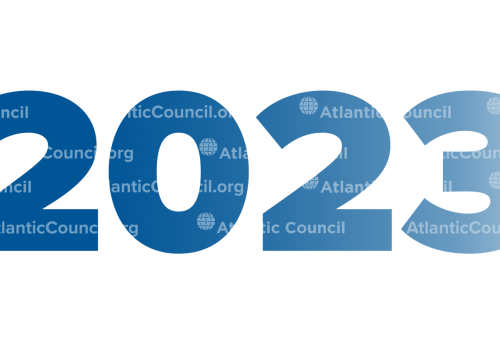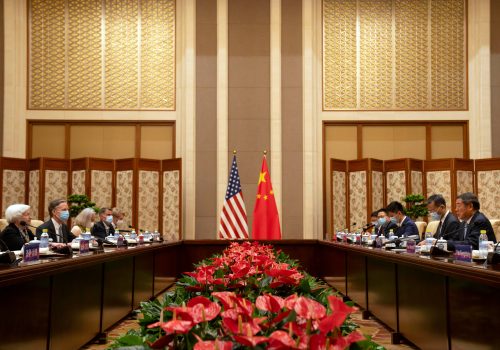Five things that did not happen in 2023
A lot happened in 2023. But for a moment consider everything that could have happened but didn’t. Think of all the outcomes that were considered likely, or even unlikely but possible, yet came to naught. Many firmly held expectations about 2023 simply never materialized. Yet these acts of imagination nonetheless had real-world effects, determining where attention was directed and resources spent. Below, Atlantic Council experts look at five events that notably did not happen in 2023 and what they reveal about the world going into 2024.
Click to jump to an expert analysis:
Josh Lipsky: The US economy did not go into recession
Matthew Kroenig: Russia did not use a nuclear weapon in Ukraine
Kitsch Liao: China did not invade Taiwan
Yevgeniya Gaber: Russia did not stop Ukraine from exporting grain
L. Daniel Mullaney: The US and EU did not tumble into a trade war
The US economy did not go into recession
Economists don’t have a great track record at predicting recessions—and 2023 was no exception. At the beginning of the year, many private and public sector forecasters thought a global recession was “inevitable.” Bloomberg even pegged the odds of a US recession at 100 percent. (Treasury Secretary Janet Yellen pointed out that they got this one wrong in an interview with them in October.)
Of course, if you were paying close attention to the GeoEconomics Center, you could have calculated those odds a little differently. In January, we hosted an event with Jan Hatzius, chief economist at Goldman Sachs, and Megan Greene of the Bank of England, both of whom laid out how the United States might avoid a recession. Their analysis was against the grain, but it was right. Why? First of all, the global energy shock that many thought would come to define 2023 hasn’t materialized. The United States reached a record high for natural gas output, the winter was warmer than expected in Europe, and, ironically, a slowing global economy reduced demand. That’s a recipe for a so-called “soft landing.” In the United States, something strange happened with the labor force. Even with the Federal Reserve going on an interest rate hiking spree, the economy continued to add jobs at a healthy clip (averaging over 250,000 monthly over 2023). In the past, Federal Reserve tightening like this would have hammered the job market harder, but this time pent-up savings from the pandemic helped give the US economy momentum. The bottom line is that the COVID-19 pandemic presented an economic shock unlike any other—so perhaps we shouldn’t have been surprised that the recovery didn’t follow the normal rules.
But here’s the thing—gravity has a way of always coming back. So just because most analysts now think we’re on a smooth path to low inflation and continued gross domestic product growth, last year was a reminder of just how far off those predictions can be.
—Josh Lipsky is the senior director of the Atlantic Council’s GeoEconomics Center. He previously served as an adviser at the International Monetary Fund (IMF) and speechwriter to Christine Lagarde.
Russia did not use a nuclear weapon in Ukraine
One year ago, many analysts worried that Russia might use nuclear weapons in Ukraine sometime in 2023. Fortunately, the year has come and gone without a whiff of split atoms. Why did Russian President Vladimir Putin refrain from pulling the nuclear trigger?
There are two major reasons. First, Ukraine’s 2023 counteroffensive was less successful than many anticipated. The nuclear escalation scenario that analysts feared most was a stunning Ukrainian counteroffensive leading Putin to choose a limited use of nonstrategic nuclear weapons on the battlefield as preferable to losing a war on Russia’s border in a humiliating fashion—a loss that could have even threatened Putin’s hold on power in Moscow. Instead, 2023 saw a grinding, defense-dominant war in which the battle lines barely moved, saving Putin from making gut-wrenching choices about nuclear escalation.
Second, Putin was deterred by the fear of a US and NATO response. Putin has his hands full in Ukraine and does not want a major war with the West. The White House’s deterrent messages in late 2022 and early 2023 effectively reinforced these fears. Consistent with the approach I recommended in my “Memo to the President” in September 2022, the Biden administration publicly threatened “catastrophic consequences” for Russia if Putin used nuclear weapons and reportedly privately threatened direct US conventional military retaliation against Russian forces if Putin were foolish enough to order a nuclear strike. Together, these messages constituted an effective deterrent threat.
If one or both of these factors changes in 2024, however, expect concerns about Putin breaking the nuclear taboo to rise again.
—Matthew Kroenig is vice president and senior director of the Atlantic Council’s Scowcroft Center for Strategy and Security.
China did not invade Taiwan
The Chinese Communist Party (CCP) has made no secret of its desire to use force in achieving “unification” with Taiwan, a vibrant democracy it considers to be a “rogue province.” It appeared at times as if 2023 might be the year that escalating tensions set this attempted conquest in motion.
Following then-Speaker of the House Nancy Pelosi’s visit to Taipei in 2022, Taiwanese President Tsai Ing-wen met with US House Speaker Kevin McCarthy in the United States in April, which sparked another round of Chinese military exercises in response. Meanwhile, Honduras switching diplomatic recognition from Taipei to Beijing continued the ongoing fierce battle by China to deprive Taiwan of its international space in preparation for an invasion. Furthermore, 2023 also saw the People’s Liberation Army (PLA), the armed wing of the CCP, achieving an unprecedented operational tempo in and around the Taiwan Strait, augmented by information operations.
All of this created fertile ground for an imminent crisis in the Taiwan Strait in 2023, be it a blockade, an invasion, or anything in between. So why hasn’t it happened yet?
There are many longstanding reasons why China has yet to launch a full-scale invasion of Taiwan. First, the inherent difficulty of an amphibious invasion should not be underestimated. The Allied landing in Normandy during World War II saw 10,000 killed, wounded, and missing in action (out of some 160,000 troops who landed on the first day) and a breakout did not come until more than six weeks later. An invasion of Taiwan would dwarf the scale and difficulty of such an endeavor, all to be conducted by a force that has not seen combat since 1979. Secondly, by the PLA’s own estimation, its modernization to counter the US military in the Indo-Pacific region would not be completed until 2027. As it currently stands, the PLA does not appear to have the capacity to transport and sustain an invasion of Taiwan. The prospect is worsened by China’s uncertain nuclear posture and political intrigue over its Rocket Force, a primary deterrent against US intervention. While the PLA could still opt for decapitation strikes and a combination of kinetic, economic, and psychological coercive measures, these options also come with elevated risks for accidental escalation. More recently, as the operational tempo around Taiwan has ramped up, the PLA has likely faced trade-offs between keeping up its pace of modernization specifically for a blockade or invasion and sustaining, for example, more frequent intrusions into Taiwan’s Air Defense Identification Zone and other ongoing provocations.
China is also undergoing an economic slowdown, with gross domestic product growth less than 4 percent and anticipated to be sluggish into 2024. An invasion would require extraordinary commitment, disrupting as much as three trillion dollars in global trade and financial flows. The direct cost to China would be difficult to estimate, but it’s worth noting that US operations in Iraq and Afghanistan are estimated to have cost between four and six trillion dollars.
What does this mean for 2024? As Taiwan’s presidential election approaches in January, and while the CCP’s signaling toward resolving the Taiwan issue in a definite time frame continues to grow, the barriers to the CCP taking kinetic action remain high. This suggests that the military exercises will continue to establish a new normal, providing additional tools for comprehensive coercive operations against Taiwan while also providing a strength test to the PLA’s Logistic Support Force to prepare for a major operation.
Irrespective of which Taiwanese political party wins the election, expect to see a continued ramp-up in disinformation and cognitive warfare as the CCP’s methodology becomes more sophisticated, relying on wedging and amplifying disagreement and discontent on critical political issues. As for kinetic escalation, should a suitable provocation or accidental escalation present itself, the most likely scenarios remain a blockade or quarantine rather than an outright invasion.
—Kitsch Liao is an assistant director of the Atlantic Council’s Global China Hub. Previously, he worked in the US Congress, in diplomatic postings, and as a cyber intelligence analyst for the private sector.
Russia did not stop Ukraine from exporting grain
Russia’s decision to withdraw from the United Nations- and Turkey-brokered Black Sea Grain Initiative in July 2023 raised concerns about the future of Ukraine’s maritime exports and its impacts for global food markets. Many voices were quick to suggest the worst-case scenarios, amplifying Russian narratives that nothing in the Black Sea can happen without Russia’s engagement or at least its consent. However, contrary to expectations, Ukraine has not only maintained its maritime exports but also expanded them through humanitarian corridors established via the territorial waters of Romania and Bulgaria. The Ukrainian minister of infrastructure, Oleksandr Kubrakov, reported a significant increase in monthly maritime trade turnover since the launch of the corridors, from 278,000 to nearly five million tons. Despite Russian attacks, since July 2023, Ukrainian Black Sea ports have loaded 337 vessels, sometimes even surpassing the monthly dynamics of the Black Sea Grain Initiative, which Russia had often exploited for its benefit. As of December 19, Ukraine has exported ten million tons of products via 302 vessels to twenty-four countries.
Several factors have contributed to Ukraine’s success. First, innovative and creative maritime warfare tactics have allowed Ukraine to regain control, first over Snake Island and then over the “Boyko towers,” offshore oil rigs that were seized by Russia after the occupation of Crimea in 2014 and used to support its war effort ever since. This has significantly limited Russian dominance in the northwestern part of the Black Sea. While Russia still possesses some capacity to attack commercial vessels, Ukrainian counterattacks on Russian warships and navy headquarters in occupied Crimea have diminished Russia’s naval capabilities and forced most of its vessels to withdraw from the area.
Second, Western support has played a crucial role in enhancing Ukrainian air defense capabilities for protecting seaports and agricultural infrastructure, although more assistance is still needed.
Third, raising awareness of the Black Sea’s key role for Russia’s regional expansionism, as well as for Ukraine’s successful counteroffensive, has helped garner international support. The expected signing of a trilateral memorandum between Turkey, Bulgaria, and Romania for demining of the Black Sea in January 2024, along with increased naval support from the United Kingdom and Norway in a “maritime coalition” will further strengthen Ukraine’s coastal and maritime defense capabilities.
However, the battle over the Black Sea is far from over. Russia is likely to intensify its efforts in 2024 to restrict freedom of navigation, disrupt supply chains through drone and missile attacks on seaport infrastructure, harass commercial vessels, and engage in piracy and covert operations to make the Black Sea routes too costly for maritime trade.
In 2023, Ukraine has proved yet again that it can perform better than expected when it is equipped with everything it needs. Kyiv’s ability to maintain this success as a major food producer and an emerging naval power in 2024 will largely depend on the Western resolve to sustain its support—politically, militarily, and financially.
—Yevgeniya Gaber is a nonresident senior fellow at the Atlantic Council IN TURKEY and at the Centre in Modern Turkish Studies at the Norman Paterson School of International Affairs at Carleton University.
The opinions expressed here are those of the author and do not reflect the official policy or position of the employer.
The US and EU did not tumble into a trade war
In music, it’s the silence between the notes; in art, it’s the negative space between the objects; in mysteries, it’s the dog that didn’t bark. What does not happen is often as important as, or more important than, what does. So it is with US-EU trade relations.
A few examples:
By the end of October 2023, the European Union (EU) and the United States were to have reached a permanent arrangement to free up bilateral trade in steel and aluminum, removing billions of dollars in US section 232 “national security” tariffs on those products. It didn’t happen. The arrangement was being negotiated under a temporary two-year regime under which historic levels of EU steel and aluminum were entering the United States duty-free, and the EU had suspended its billions of dollars in retaliatory tariffs on other US products. This temporary regime de-escalated a potentially ugly tit-for-tat trade war and World Trade Organization (WTO) dispute settlement proceedings. Not reaching an arrangement in October risked the reimposition of many billions of dollars in US section 232 tariffs and EU retaliatory tariffs and a potentially escalating trade war.
That’s the second key thing that didn’t happen in 2023. The United States quickly signaled that it would not immediately reimpose section 232 tariffs in the absence of an arrangement, to give space for further discussions. Meanwhile, the EU recently announced that it would hold back its retaliatory tariffs for another fifteen months, although it would like more flexibility in determining the duty-free historical levels of trade.
The failure to reach a final arrangement by October was not surprising. The parties are attempting something that is extremely difficult: a wholly unprecedented arrangement that incentivizes trade in steel and aluminum that is environmentally sustainable and market-based, not just inexpensive. Indeed, one of the impediments to a final arrangement may be asymmetrical ambitions: One view is that the goal of an arrangement is to eliminate vexing and arguably insulting “national security” tariffs on EU steel and aluminum, requiring the minimum necessary to convince the United States to back off. A different view is that the arrangement should be an ambitious model for a new approach to trade agreements in general—one that does not simply remove trade barriers and favor trade in the least expensive products but also favors trade in products that are climate-friendly and market economy-based (including with respect to labor rights).
For this reason, steel and aluminum discussions aimed at fashioning new approaches to meet current challenges are enormously complicated, but also potentially very consequential. They require creativity, ambition and outer-edge-of-the-envelope thinking on the part of both parties.
Happily, there is now additional time to design a steel and aluminum arrangement that is up to the task.
Related to these nonevents is another significant event that did not happen in 2023: a US-EU trade war triggered by the 2022 Inflation Reduction Act (IRA). Initial elation from the EU that the United States had taken concrete steps to meet its Paris Agreement climate goals quickly gave way to fury that some of its provisions were considered inconsistent with WTO obligations and potentially disadvantaged EU stakeholders. For a time in 2023, complaints and threats over the IRA dominated the US-EU trade relationship and risked derailing any positive agenda.
Discussions over the IRA continue, but the threat of a trade blow-up now seems remote. This is likely due to a mix of creativity in addressing EU concerns—for instance, ongoing negotiations on critical minerals that would extend some IRA benefits to European stakeholders—and the realization that both the EU and the United States have to take unprecedented and potentially uncomfortable measures in the face of current challenges.
In sum, in US-EU trade relations, 2023 was relatively eventful in its absence of events—the silence between the notes, the dog that did not bark.
—L. Daniel Mullaney is a nonresident senior fellow with the Atlantic Council’s Europe Center and GeoEconomics Center.
Further reading
Wed, Dec 20, 2023
The Atlantic Council’s greatest hits of 2023
New Atlanticist By Frederick Kempe
Here's the best of our efforts to further our mission to shape the global future together with allies and partners in 2023.
Wed, Dec 20, 2023
By the numbers: The global economy in 2023
New Atlanticist By
Our GeoEconomics Center experts take you inside the numbers that mattered—including many you may have missed—in 2023.
Mon, Dec 18, 2023
2023: A year in the Middle East
MENASource By
2023 was a tumultuous and tragic year for the Middle East and North Africa. It also produced moments of hope and diplomatic feats.
Image: New years eve numerals 2023 arrive in Times Square on December 20, 2022 in New York City, NY, USA. The numerals will stay on the plaza and members of the public will have the opportunity to take photos with them through noon on Friday, December 23. Photo by Charles Guerin/ABACAPRESS.COM


